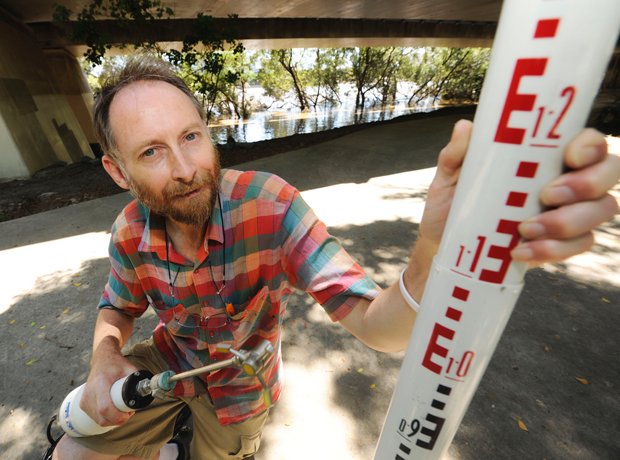World’s first live flood test yields vital data

A QUEENSLAND SCIENTIST HAD nothing but a rope to stop him being swept into the surging Brisbane River during a world-first experiment that could help save people trying to escape floodwaters in urban areas, and also shape future policies.
Queensland University of Technology’s (QUT) fluid mechanics researcher Professor Richard Brown’s quick-thinking – and courage – saw him jump into the university’s flooded ground-floor car park without a life jacket, about 100 m from where the banks of the Brisbane River are usually found.
The 13 January peak was due to hit in about eight hours, and the scientist wanted to position his acoustic doppler celocimeter inside the car park to measure water velocity and sediment concentration inside the flooded building, the world’s first real-life experiment.
Richard says he was surprised how quickly the water was swirling and thrusting in the car park, which was about 1.2 m in depth. “It surges a lot,” he says. “We were surprised at how dangerous it was, the most stunning finding was the sudden changes in velocity.”
Flood policy in Queensland
The velocimeter measured the water speed over 48 hours, during which time it was knocked about by debris and wheelie bins. But being inside a building was no protection for it against water strong enough to knock people off their feet.
The water flowed at 0.3 m per second – a rate at which an average person can still stand up – but within just 40 seconds it could suddenly surge to 1.8 m per second, Richard says. “Which is so swift and strong it would knock a person over.” Exacerbating the dangerous waters were smooth floors, which offered no resistance or interruption to the flow.
The experiment will no doubt catch the attention of authorities, when scripting future flood advice for those in urban areas. Richard says the findings will be of use to urban planners, building designers and engineers, flood modellers and of course, disaster management planners: “this sort of information will assist architects and designers to build safer buildings with railings, places of refuge or ways to slow water flow,” he says.
Flood research risk
But there were no safety features for him to hold onto while positioning the velocimeter before the experiment. He and his team tied a rope across the carpark, so if he lost his footing it would hopefully catch him before being sucked out and into the swollen river.
It was an “opportunistic experiment” and took some convincing for him to be allowed into the danger zone. “We had to get through road blocks in the city, get through security at the university without any formal permission … but after a day of that we eventually set it up,” he says. Though he admits it was probably a slightly dangerous experiment, he says it garnered valuable new data.
“No one has really looked at the flow through buildings,” he adds. “So when designing things in the future, especially in flood prone areas, this information will help us to do that.”
RELATED STORIES

